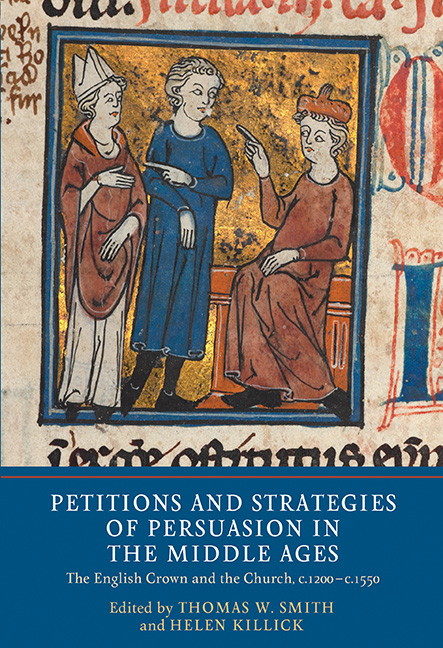 Petitions and Strategies of Persuasion in the Middle Ages
Petitions and Strategies of Persuasion in the Middle Ages Book contents
- Frontmatter
- Dedication
- Contents
- Contributors
- Foreword
- Acknowledgements
- List of Abbreviations
- Introduction: Medieval Petitions and Strategies of Persuasion
- 1 Blood, Brains and Bay-Windows: The Use of English in Fifteenth- Century Parliamentary Petitions
- 2 Petitioners for Royal Pardon in Fourteenth-Century England
- 3 The Scribes of Petitions in Late Medieval England
- 4 Patterns of Supplication and Litigation Strategies: Petitioning the Crown in the Fourteenth Century
- 5 Petitions of Conflict: The Bishop of Durham and Forfeitures of War, 1317–1333
- 6 A Tale of Two Abbots: Petitions for the Recovery of Churches in England by the Abbots of Jedburgh and Arbroath in 1328
- 7 ‘By Force and Arms’: Lay Invasion, the Writ de vi laica amovenda and Tensions of State and Church in the Thirteenth and Fourteenth Centuries
- 8 The Papacy, Petitioners and Benefices in Thirteenth-Century England
- 9 Playing the System: Marriage Litigation in the Fourteenth Century
- 10 Killer Clergy: How did Clerics Justify Homicide in Petitions to the Apostolic Penitentiary in the Late Middle Ages?
- Index
10 - Killer Clergy: How did Clerics Justify Homicide in Petitions to the Apostolic Penitentiary in the Late Middle Ages?
Published online by Cambridge University Press: 20 August 2020
- Frontmatter
- Dedication
- Contents
- Contributors
- Foreword
- Acknowledgements
- List of Abbreviations
- Introduction: Medieval Petitions and Strategies of Persuasion
- 1 Blood, Brains and Bay-Windows: The Use of English in Fifteenth- Century Parliamentary Petitions
- 2 Petitioners for Royal Pardon in Fourteenth-Century England
- 3 The Scribes of Petitions in Late Medieval England
- 4 Patterns of Supplication and Litigation Strategies: Petitioning the Crown in the Fourteenth Century
- 5 Petitions of Conflict: The Bishop of Durham and Forfeitures of War, 1317–1333
- 6 A Tale of Two Abbots: Petitions for the Recovery of Churches in England by the Abbots of Jedburgh and Arbroath in 1328
- 7 ‘By Force and Arms’: Lay Invasion, the Writ de vi laica amovenda and Tensions of State and Church in the Thirteenth and Fourteenth Centuries
- 8 The Papacy, Petitioners and Benefices in Thirteenth-Century England
- 9 Playing the System: Marriage Litigation in the Fourteenth Century
- 10 Killer Clergy: How did Clerics Justify Homicide in Petitions to the Apostolic Penitentiary in the Late Middle Ages?
- Index
Summary
Violence in its many forms – warfare, murder, manslaughter or assault – was an omnipresent phenomenon in medieval society. It was especially linked to lay society, but members of the clergy were not immune to it either. Medieval sources – court records, annals, treatises and many others – tell about clergymen involved in violent events. In these sources clergymen are typically victims of a violent act committed by a layperson. But, even though the ecclesiastical legislation strictly forbade members of the clergy from acting violently, medieval sources also contain a lot of information about clergymen who committed violent crimes. Particularly good source material for the study of clerical violence comes from the register series of the apostolic penitentiary, which contains numerous petitions from clergymen all over Christendom asking for pardon because of violent behaviour.
The aim of this chapter, which is based on the late fifteenth- and early sixteenth-century penitentiary documentation, is to examine what kinds of strategy the clergymen who turned to the penitentiary applied in order to get their consciences cleansed. In particular, it analyses the wording that the clients of the penitentiary accused of homicide used in their petitions in order to convince papal officials of their innocence.
Canon Law and Violent Clergy
According to the principle of the fifth commandment (‘Thou shalt not kill’, Ex. 20:13), the ecclesiastical norms did not tolerate any form of violence or killing. Since members of the clergy were supposed to act as models for laypeople, the ecclesiastical norms required clergymen to abstain from violence. In order to protect the peaceful clergymen from lay violence the Second Lateran Council (1139) stipulated in its constitution no. 15 – known as Si quis suadente – that anyone who laid violent hands on the members of the clergy or on men or women in monastic vocation incurred automatic excommunication, which could be lifted only by a papal absolution. This constitution became part of what is now known as privilegium canonis and refers to the special protection of clergymen against any kind of assault. As Peter Clarke has pointed out, this was not the only way the Church tried to protect its officials. The Church introduced also another privilege, privilegium fori, according to which only a clergyman could judge the misdeeds of another clergyman. In practice, this privilege meant that the crimes committed by clergymen had to be judged in ecclesiastical tribunals.
- Type
- Chapter
- Information
- Petitions and Strategies of Persuasion in the Middle AgesThe English Crown and the Church, c.1200–c.1550, pp. 202 - 218Publisher: Boydell & BrewerPrint publication year: 2018


